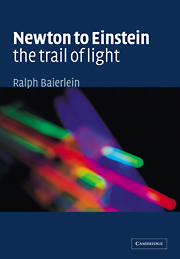 Newton to Einstein: The Trail of Light
Newton to Einstein: The Trail of Light Published online by Cambridge University Press: 05 June 2012
Does the inertia of a body depend on its energy content?
Albert Einstein, title of his first paper on E=mc2Energy, mass, and momentum reviewed
Easily the most famous result of relativity theory is the equation E=mc2. In this chapter, we learn where the equation comes from, what it means, and what it does not mean. To do so, we need to be clear about what certain terms in physics mean, and so this section reviews the essential concepts. If you have not yet read appendix A, “Energy,” or have not done so recently, please read it before proceeding any farther in this chapter. Then this section will indeed be a review.
Because this section is a review, the topics are presented in telegraphic style.
Energy: the ability to do work, for example, to lift a weight. Energy is an attribute of a physical object or of whatever is contained in a specified region of space.
As figure 11.1 shows, a moving object can be used to lift a weight. Thus there is energy associated with motion, called “kinetic” energy, from the Greek verb “kinein,” meaning “to move.”
The higher the object starts, the more kinetic energy it has when it hits. Thus the greater the height, the more potential for kinetic energy at the bottom. Physics introduces the idea of a “gravitational potential energy,” an energy associated with position in the earth's gravitational field.
To save this book to your Kindle, first ensure [email protected] is added to your Approved Personal Document E-mail List under your Personal Document Settings on the Manage Your Content and Devices page of your Amazon account. Then enter the ‘name’ part of your Kindle email address below. Find out more about saving to your Kindle.
Note you can select to save to either the @free.kindle.com or @kindle.com variations. ‘@free.kindle.com’ emails are free but can only be saved to your device when it is connected to wi-fi. ‘@kindle.com’ emails can be delivered even when you are not connected to wi-fi, but note that service fees apply.
Find out more about the Kindle Personal Document Service.
To save content items to your account, please confirm that you agree to abide by our usage policies. If this is the first time you use this feature, you will be asked to authorise Cambridge Core to connect with your account. Find out more about saving content to Dropbox.
To save content items to your account, please confirm that you agree to abide by our usage policies. If this is the first time you use this feature, you will be asked to authorise Cambridge Core to connect with your account. Find out more about saving content to Google Drive.